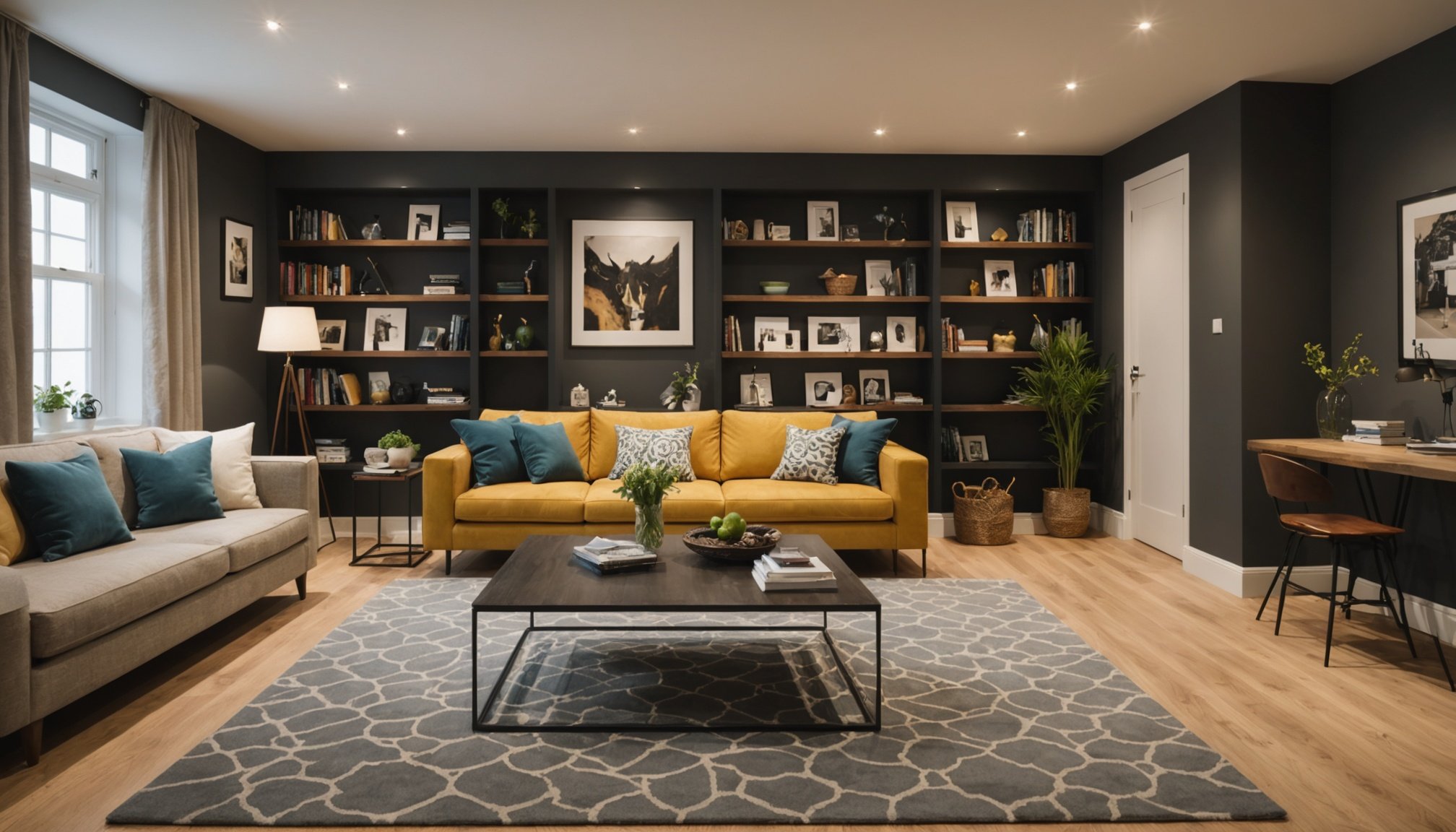Transforming a UK basement flat can be a rewarding challenge. Low-light spaces often feel claustrophobic, but with creativity, they can become inviting havens. Discover innovative techniques such as strategic lighting, bold color choices, and thoughtful decor that breathe life into your basement. Whether you aim to create a cozy retreat or a vibrant workspace, these ideas will enhance appeal while maximizing space. Embrace the potential of your basement flat and transform darkness into a canvas for creativity and comfort.
Innovative Design Solutions for Basement Flats
Designing a basement flat can present unique challenges, but with some creative space solutions, you can transform even the most compact areas into functional and stylish living spaces.
A lire en complément : Transforming a UK Cottage: Designing a Charming Open-Plan Living Space That Retains Character
One effective strategy is to maximize vertical space. Installing shelving and storage units that reach up to the ceiling can significantly increase your storage capacity without taking up valuable floor space. This not only helps in organizing your belongings but also draws the eye upward, creating an illusion of a taller room.
Multifunctional furniture is another key element in optimizing a basement flat. Pieces like sofa beds, extendable dining tables, and storage ottomans can serve multiple purposes, allowing you to make the most of your limited square footage. By selecting furniture that adapts to different needs, you can maintain a clutter-free environment while ensuring all essential functions are covered.
A lire aussi : Unlocking Water Efficiency: Innovative Smart Tech Solutions for Homes in the UK
Incorporating mirrors is an excellent way to enhance both light and space perception in a basement flat. Mirrors reflect light, making the space feel brighter and more open. Placing mirrors strategically across from windows or light sources can amplify natural light, giving the illusion of a larger, airier room.
By implementing these design solutions, basement flats can become inviting and efficient living spaces.
Effective Lighting Techniques for Low-Light Spaces
Lighting in a basement flat is crucial to creating a welcoming atmosphere. With limited natural light, innovative basement lighting solutions can transform a dim space into a bright, inviting home.
Layered Lighting Approaches
A layered approach to lighting combines different types of lighting to achieve a balanced and functional environment. Ambient lighting forms the base layer, providing general illumination. This can be achieved through ceiling fixtures or recessed lighting. Task lighting focuses on specific areas, such as reading nooks or kitchen counters, using desk lamps or under-cabinet lights. Accent lighting highlights architectural features or artwork, adding depth and interest to the space.
Utilizing Natural Light Sources
Maximizing natural light is essential in low-light spaces. If your basement flat has windows, keep them unobstructed to allow as much light as possible. Light-coloured window treatments can diffuse sunlight without blocking it. Mirrors, as previously mentioned, can also help reflect and amplify natural light throughout the room.
Smart Lighting Options and Controls
Incorporating smart lighting solutions can enhance convenience and energy efficiency. Smart bulbs and dimmers allow you to adjust lighting levels remotely, tailoring the ambiance to suit your needs. These systems can also be programmed to simulate natural light cycles, promoting a sense of well-being in spaces with limited daylight.
Color Schemes That Brighten Up Basement Flats
Choosing the right color schemes for small spaces can dramatically transform a basement flat, creating an airy and inviting atmosphere. Light and neutral colors are ideal for these environments, as they reflect more light and make the space feel larger. Shades like soft whites, pale greys, and light pastels can open up a room, enhancing its overall brightness.
To add depth and character, consider incorporating accent walls. These can be painted in slightly darker or bolder hues to create contrast without overwhelming the space. An accent wall can draw attention to a specific area, such as a seating nook, and alter the perception of room dimensions, making it feel more dynamic.
Color psychology plays a crucial role in influencing mood within a basement flat. Soft blues and greens can evoke calmness and serenity, while yellows and oranges bring warmth and energy. By carefully selecting colors that align with desired emotions, you can enhance the comfort and functionality of your living space.
When planning your basement color ideas, remember to balance aesthetics with practicality. Opt for durable, easy-to-clean finishes that withstand the unique conditions of basement living, ensuring your space remains both beautiful and functional.
Furniture Arrangements to Optimize Space
Crafting an effective furniture layout is essential for achieving space optimization in a basement flat. By strategically arranging pieces, you can enhance both functionality and aesthetics.
Open Floor Plans vs. Defined Areas
Deciding between an open floor plan and defined areas is crucial. Open floor plans create a sense of spaciousness, ideal for smaller spaces. They allow for flexible furniture arrangements and promote social interaction. Conversely, defined areas provide structure, which can be beneficial for delineating different functions, like a separate dining or work area. Consider your lifestyle needs before choosing.
Arranging Furniture for Flow and Functionality
Arranging furniture to ensure flow and functionality is key. Start by identifying focal points, such as windows or a fireplace, and arrange seating to face these. Ensure there is ample walking space between pieces to avoid a cramped feel. Use rugs to anchor seating areas and create visual boundaries in open spaces.
Tips for Selecting the Right Size Furniture
Selecting the right size furniture is vital. Opt for pieces that fit the scale of your room. Compact, multifunctional furniture like modular sofas or nesting tables can maximize space without overwhelming it. Measure your space and plan layouts before purchasing to ensure each piece complements the overall design.
Storage Solutions for Efficient Organization
Efficient organization in a basement flat demands creative storage solutions that make the most of every nook and cranny. One of the most innovative basement storage ideas is to utilize the space under the stairs. This often-overlooked area can be transformed into a series of drawers or shelves, perfect for storing shoes, books, or seasonal items. Custom cabinetry can also be designed to fit these unique spaces, offering a seamless and stylish solution.
Incorporating built-in cabinetry is another effective method for maximizing storage space. Custom solutions can be tailored to fit awkward corners or sloped ceilings, providing ample storage without intruding on living areas. These units can be designed to blend with the room's decor, maintaining a cohesive look while offering practicality.
Decluttering strategies are essential for small spaces to prevent overcrowding. Begin by evaluating items regularly and donating or discarding those that are no longer needed. Use clear storage bins to keep items visible and accessible, and label everything to streamline organization. By implementing these strategies, you can ensure your basement flat remains tidy and functional, making the most of every available inch.
UK-Specific Considerations and Regulatory Advice
Navigating the complexities of UK home improvement projects, particularly basement conversions, requires an understanding of specific regulations and permissions.
Building Regulations for Basement Conversions
In the UK, basement conversions must comply with building regulations to ensure safety and structural integrity. These regulations cover aspects such as fire safety, ventilation, and damp-proofing. It's essential to work with a qualified professional who can guide you through the compliance process, ensuring that all necessary standards are met.
Planning Permissions and Considerations
Obtaining planning permission is a critical step in basement conversions. While not always required, it depends on factors like the building's location and the nature of the work. For example, listed buildings or properties in conservation areas often demand more stringent permissions. Consulting with local planning authorities can help clarify these requirements and avoid potential legal issues.
Energy Efficiency Tips for UK Homes
Enhancing energy efficiency in basement conversions is both environmentally and financially beneficial. Consider installing high-quality insulation to reduce heat loss and improve thermal comfort. Additionally, energy-efficient lighting and appliances can further lower energy consumption. Incorporating these elements not only aligns with UK sustainability goals but also contributes to long-term savings.











